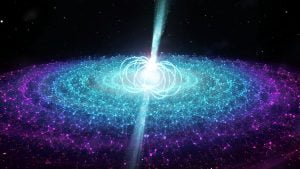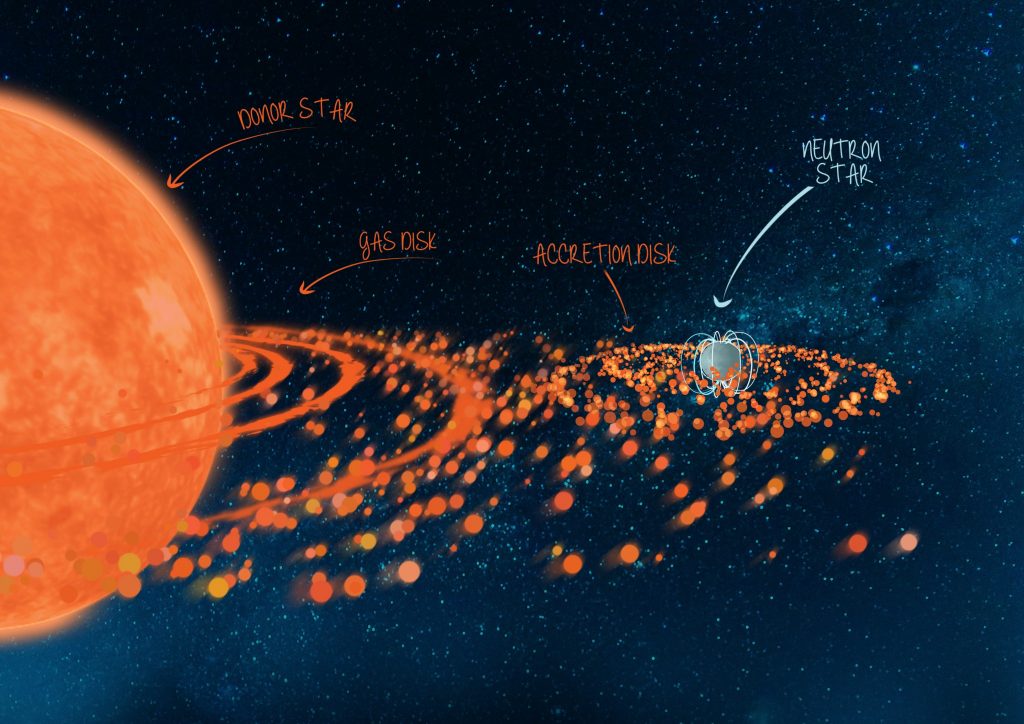Astronomers have detected radio jets belonging to a neutron star with a strong magnetic field — something not predicted by current theory, according to a new study published in Nature today.
The team, led by researchers at the University of Amsterdam, observed the object known as Swift J0243.6+6124 using the Karl G. Jansky Very Large Array radio telescope in New Mexico and NASA’s Swift space telescope.

An artist’s impression of the strong magnetic field neutron star in Swift J0243.6+6124 launching a jet. During the bright outburst event in which it was first discovered, the neutron star in Swift J0243.6+6124 was accreting at a very high rate, producing copious X-ray emission from the inner parts of the accretion disk. At the same time, the team detected radio emission with a sensitive radio telescope, the Karl G. Jansky Very Large Array in the USA. By studying how this radio emission changed with the X-rays, we could deduce that it came from fast-moving, narrowly-focused beams of material known as jets, seen here moving away from the neutron star magnetic poles. Credit: ICRAR/University of Amsterdam.
“Neutron stars are stellar corpses,” said study co-author Associate Professor James Miller-Jones, from Curtin University’s node of the International Centre for Radio Astronomy Research (ICRAR).
“They’re formed when a massive star runs out of fuel and undergoes a supernova, with the central parts of the star collapsing under their own gravity.
“This collapse causes the star’s magnetic field to increase in strength to several trillion times that of our own Sun, which then gradually weakens again over hundreds of thousands of years.”
University of Amsterdam PhD student Jakob van den Eijnden, who led the research, said neutron stars and black holes are sometimes found in orbit with a nearby “companion” star.
“Gas from the companion star feeds the neutron star or black hole and produces spectacular displays when some of the material is blasted out in powerful jets travelling at close to the speed of light,” he said.
This visualisation shows what the team think the binary system looks like, and what happened during the bright outburst in which it was discovered.
Astronomers have known about jets for decades but until now, they had only observed jets coming from neutron stars with much weaker magnetic fields. The prevailing belief was that a sufficiently strong magnetic field prevents material getting close enough to a neutron star to form jets.
“Black holes were considered the undisputed kings of launching powerful jets, even when feeding on just a small amount of material from their companion star,” Van den Eijnden said.
“The weak jets belonging to neutron stars only become bright enough to see when the star is consuming gas from its companion at a very high rate.

An artist’s impression of the binary system Swift J0243.6+6124. A binary system with a neutron star in a 27-day orbit and a more massive, rapidly-rotating donor star. The rapid rotation of the donor star throws off a disk of material around the stellar equator. As the neutron star passes through the disk during its orbit, it picks up some of this outflowing gas, which then spirals in towards the neutron star in an accretion disk. Credit: ICRAR/University of Amsterdam.
“The magnetic field of the neutron star we studied is about 10 trillion times stronger than that of our own Sun, so for the first time ever, we have observed a jet coming from a neutron star with a very strong magnetic field.
“The discovery reveals a whole new class of jet-producing sources for us to study,” he said.
Astronomers around the world study jets to better understand what causes them and how much power they release into space.
“Jets play a really important role in returning the huge amounts of gravitational energy extracted by neutron stars and black holes back into the surrounding environment,” Associate Professor Miller-Jones said.
“Finding jets from a neutron star with a strong magnetic field goes against what we expected, and shows there’s still a lot we don’t yet know about how jets are produced.”
Narrated animation describing the findings and what they mean (English).
Original Publication:
‘An evolving jet from a strongly-magnetised accreting X-ray pulsar’, published in Nature on September 26th, 2018.
More Information:
Netherlands Research School for Astronomy
The Nederlandse Onderzoekschool Voor Astronomie (NOVA), or the Netherlands Research School for Astronomy, is a collaboration of the astronomical institutes belonging to the universities of Amsterdam, Groningen, Leiden, and Nijmegen. NOVA’s mission is to carry out frontline astronomical research and to train young astronomers at the highest international level. www.astronomie.nl
ICRAR
The International Centre for Radio Astronomy Research (ICRAR) is a joint venture between Curtin University and The University of Western Australia with support and funding from the State Government of Western Australia. www.icrar.org
The Very Large Array
The Karl G. Jansky Very Large Array (VLA) is a radio astronomy observatory located in central New Mexico that comprises twenty-seven 25-metre radio telescopes deployed in a Y-shaped array. Astronomers using the VLA have made key observations of black holes, studied protoplanetary disks around young stars, discovered magnetic filaments and traced complex gas motions at the Milky Way’s centre, probed the Universe’s cosmological parameters, and provided new knowledge about the physical mechanisms that produce radio emission.
Swift
NASA’s Swift space telescope was designed to observe gamma-ray bursts— the brightest electromagnetic events known to occur in the universe. The Swift observatory comprises three telescopes, which work in tandem to provide rapid identification and multi-wavelength follow-up of gamma-ray bursts and their afterglows. Within 20 to 75 seconds of a detection, the observatory will rotate autonomously, so the on-board X-ray and optical telescopes can view the burst.
Multimedia:
Researcher interview with Associate Professor James Miller-Jones
A/Prof James Miller-Jones, from the Curtin University node of the International Centre for Radio Astronomy Research, discusses the findings and why he finds them so exciting.
Visualisation of the outburst of the binary system Swift J0243.6+6124
This visualisation shows what the team think the binary system looks like, and what happened during the bright outburst in which it was discovered. The neutron star picks up matter from the disk of gas thrown off the rapidly-rotating donor star. This piles up in an accretion disk around the neutron star, whose strong magnetic field (over a trillion times that of the Sun) prevents the disk from reaching all the way in to the neutron star. During the outburst, material in the disk moved inwards towards the neutron star, causing the disk to shine brightly in X-rays. Against expectations, the team also detected a bright radio jet, showing that high magnetic fields do not prevent jet formation after all. As the outburst decayed away, the jet faded in tandem with the decrease in the X-ray emission from the disk. Credit: ICRAR/University of Amsterdam.
Narrated animation describing the findings and what they mean
This animation describes our previous understanding of neutron stars and their jets, and explains why this discovery was so surprising, how it was made, and what it means. English/Dutch versions both available. Credit: ICRAR/University of Amsterdam.
Contacts:
Jakob van den Eijnden (University of Amsterdam)
Ph: +31 6 48163504 E: A.J.Vandeneijnden@uva.nl
Associate Professor James Miller-Jones (ICRAR / Curtin University)
James is currently travelling but will respond to media enquiries within 3-4 hours. Please call or email Pete Wheeler or Lucien Wilkinson (contact details below).
Pete Wheeler (Media Contact, ICRAR)
Ph: +61 423 982 018 E: Pete.Wheeler@icrar.org
Lucien Wilkinson (Media Consultant, Curtin University)
Ph: +61 401 103 683 E: Lucien.Wilkinson@curtin.edu.au

